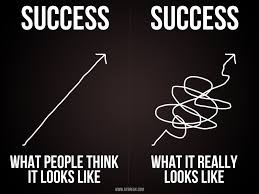If you’ve successfully started your business down the path of growth that we discussed in “The Dynamics of Growth, part 1: Setting Your Business Up for Success,” your small business or medium-sized business (SMB) has honed in on what you do best and hopefully the business is beginning to flourish. How do you keep that going while making sure that your employees and clients also succeed?
Continued business success depends on building a growth culture, and that’s what we’ll cover in this article, the second in our Dynamics of Growth for SMBs series that looks to identify how to help small businesses identify their goals, create a growth culture, and understand the challenges of success.
Growth is a Rollercoaster
 We have all seen the meme at right of what people think success looks like: a straight, upward reaching line. Next to it is another image, showing what success actually looks like: a squiggly line that seems to be going nowhere, until it finally arcs upward.
We have all seen the meme at right of what people think success looks like: a straight, upward reaching line. Next to it is another image, showing what success actually looks like: a squiggly line that seems to be going nowhere, until it finally arcs upward.
Depending on how things are going in your business, your growth might seem to be following either of these trajectories on any given day..
But, while endless, straight line growth isn’t realistic, the idea that growth suddently springs out of confusion probably isn’t accurate either.
One of our favorite authors, Les McKeown, hypothesized an alternative growth model: the Predictable Success Scalability Model. McKeown’s growth model has three growth stages that businesses must go through before finally achieving sustainable growth:
- Early Struggle—Your business only has one or two people doing all the work, trying to keep the doors open, pay bills and putting out fires. You are building a foundation for future growth.
- Fun Stage—Finally, clients are buying into your vision, paying becomes bills easier, you have internal systems that are working, there are fewer fires to deal with, and you are providing your clients with results and growth opportunities for staff. If your business keeps growing, it will hit the next phase.
- Whitewater—Your processes begin breaking down because you are too highly in demand. If you can get past this stage, McKeown says that Predictable Success and sustainable growth follow. How can you work through this last, and toughest, stage?
Growth Culture: It’s the People
A growth culture can help your small business thrive and achieve Predictable Success, although it means operating by a different set of rules than most small businesses. It means making decisions based on the purpose, values and vision of your business. And in no other area is this more true than in your hiring process.
If you want your small business to surpass the Whitewater stage, skills, abilities and technical chops are not enough for potential new hires. You need to be looking for something more. You must consider how those potential employees will fit into your work culture. Skills are important, but in a growth culture they’re secondary to questions such as, whether the employee’s own internal sense of purpose and values align with those of your business. That’s because, in addition to being able to do their jobs well, a growth culture also depends on employees being motivated to solve problems and able to work with others to make that happen.
This can be hard to determine unless you make culture fit and values alignment a key part of your hiring process. Technical skills can be taught, while people skills – teamwork, leadership, problem solving and “emotional IQ” – are much more difficult to teach. Yet, in multiple studies, it’s these soft skills and attributes such as culture fit that are often the strongest indicator of how well an employee will perform and how long they’ll stay with your organization.
Measuring People Skills
It’s tricky to measure people skills and personality attributes and determine which ones are most needed in a particular role. Fortunately, there are tools that can help, such as the Myers-Briggs Personality Indicator, DiSC profile, or Gallup’s StrengthsFinder tool. Tools like these measure personality attributes, identify how people interact with others, or identify the strengths that an individual can leverage to be more effective in their role. Gallup research has found that people who use their strengths are more engaged and productive at work. Nearly 7 in 10 employees who say their manager focuses on their strengths are more engaged.
At Tolar Systems, we use a tool called the Synergy assessment to identify the personalities, leadership and work styles that can boost growth in a small business:
- Visionaries to focus on purpose and strategy: What will we do and why?
- Operators to focus on execution: What needs to be done?
- Structures to focus on creating systems and processes: How will things be done?
- Synergists to bring the other types together: How can we all work together?
We favor this assessment because we believe that In order for our business to grow, we need a mix of vision, execution, processes and synergy to bring it all together. The assessment that will work best for your business will vary depending on what kind of culture you’re trying to build.
Tools to Build a Growth Culture
A growth culture goes beyond putting the right people in the right roles. It also requires empowering them with the training and tools they need to help your business succeed.
Strengths Based Management
An important caveat about personality-based testing is that even people that show strengths in a necessary area will still require development to become the best they can be, professionally and personally. And although personality cannot necessarily be changed, aspects of it can be developed and employees taught how to better leverage their strengths to make a stronger contribution. That’s one reason why mentoring programs and managing for strengths, rather than correcting weaknesses, is a key component of a growth culture.
Training and Development
Training courses are also available through online education or outside resources to help employees develop in a variety of areas that may be important to your business. Classes covering topics ranging from management skills and leadership training, to negotiation and conflict resolution, time management, public speaking and even relaxation and mindfulness are available through platforms like Udemy and Coursera, or through a local university or community college. Industry professional development organizations are also a great resource for additional training. Making investments in your people that help them build their skills to become more effective members of your team can have a direct effect on your business success.
Technology and Tools
Technology is also a key tool for business success and growth. It helps people collaborate and communicate more effectively, and manage business processes more efficiently, no matter what industry you’re working in. A recent study by Deloitte found that, when compared to those with minimal levels of technology engagement, digitally engaged small businesses showed:
- Three times the level of job creation.
- Four times the revenue growth, and
- Two times the revenue per employee.
Clearly, technology investment is important for organizations that want to grow. And fortunately, even small businesses can access enterprise-grade technology and business tools at a reasonable cost by leveraging the cloud. Working with a managed IT service provider is another way to keep your business up to date with the latest strategies to streamline your business processes and protect your important business data.
Tolar Systems: Tools and Strategies for Growth
Building a growth culture means understanding the growth cycle, hiring people that can help you navigate it even when waters get rough, and giving them the tools they need to be successful. If your organization is looking to grow but need strategies to manage technology while supporting your people, contact Tolar Systems today.
Read Dynamics of Growth for SMBs Part 3: Overcoming Growth Challenges
